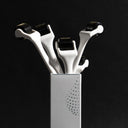The Norwood Scale is the most widely used classification method for measuring the severty of male pattern hair loss. Male pattern hair loss affects a significant portion of men across the world, and it can take many forms.
The Norwood Scale, also called the Hamilton-Norwood Scale, helps to identify and diagnose the various patterns and extents male pattern baldness can take. Because of this, it plays a vital role as a starting point and reference point for effective hair loss treatment options.
Courtesy of BaldCafe
Related reads:
- Minoxidil Foam vs. Liquid: Pick Your Match
- How To Make Hair Grow In Bald Spots?
- Does Minoxidil Work On Frontal Baldness?
Table of content
The Norwood Scale and Male Pattern Hair Loss
While hair loss can affect everyone from every age, the Norwood Scale is used to help with androgenetic alopecia, or male pattern hair loss, rather than other forms of hair loss like alopecia areata, post-partum alopecia, or traction alopecia.
Also known as male pattern balding, Male pattern hair loss is a condition that affects hald of men over the age of 50. It is caused by DHT, a male hormone that forms when testosterone is converted with an enzyme called 5α-reductase. It causes balding in men by shrinking the hair follicles and making them too weak to keep a hair. Male pattern hair loss begins when a healthy hairline eventually turns into a Norwood 1 hairline, and eventually progresses to a Norwood 3 hairline, before developing hair loss on the crown of the head, and ultimately, baldness. The Norwood Scale helps to identify where in the male hair loss process a patient is.
As your leading source for hair health information over the past 4 years, we never compromise on accuracy. When it comes to your health, you deserve information you can truly rely on - and earning your trust is our top priority.
Here's how Scandinavian Biolabs ensures every piece of content meets the highest standards of accuracy and integrity:
- Credentialed Experts: Our reviewers are actively practicing doctors and medical researchers
- Stringent Reviews: Content undergoes rigorous editing by subject specialists and review by a practicing doctor.
- Evidence-Based: We rely on well-established research from trusted scientific sources like peer-reviewed journals and health authorities.
- Full Transparency: Our editorial standards, writer credentials, reviewer credentials, correction process, and funding are all publicly documented.
- Independent Voice: While we do promote products, we operate in a vacuum to business operations. Our main goal is just an unwavering commitment to providing medically-sound guidance.
You can count on Scandinavian Biolabs to consistently deliver the trustworthy health information you deserve. Read our Editorial Standards.
Breaking down the Norwood Scale

The Norwood Scale works using 7 stages of hair loss. Each stage describes the severity of hair loss and provides a visual guide to how this stage of hair loss may look. Determining where a patient fits on the Norwood Scale can help determine the best course of treatment for them.
Stage 1
Stage 1 of the Norwood Scale represents no significant hair loss. A Norwood 1 hairline is perfectly in tact. It has not yet receded or thinned at all.
Stage 2
Stage 2 is also called an adult hairline. At this stage, there is some minor recession of the hairline around the temples. Other than this slight recession, the hairline and scalp as a whole is not affected by male pattern hair loss.
Stage 3
Stage 3 of the Norwood Scale is when the first clinical signs of male pattern balding appear. The typical V- , U-, or M-shape of male pattern hair loss starts to form with the deep recession of the Norwood 3 hairline at the temples.
A second stage 3 is also present in the Norwood Scale. Stage 3 Vertex is the stage on the Norwood Scale where, over and above the deeper, noticeable recession of the Norwood 3 hairline at the temples, hair loss starts to affect the crown of the head on an area called the vertex.
Stage 4
Stage 4 of the Norwood Scale exhibits even more severe recession of the hairline and a more severe level of hair loss at the vertex, with it having very little to absolutely no hair. A strip of thicker hair separates the receding hairline and the vertex.
Stage 5
At stage 5, the signs of a stage 4 state of hair loss are a litte more exaggerated. There is still a strip of hair separating the vertex and the temples, but this strip is starting to be affected by hair loss, both thinning and becoming narrower.
Stage 6
The balding areas of the temples and the vertex join in stage 6 of the Norwood Scale. The strip that separated them is either completely gone, or virtually absent with sparse hair coverage.
Stage 7
Stage 7 of the Norwood Scale is the final and most severe stage of hair loss. The only remaining hair on the scalp is a band from behind one ear to behind the other. The hair in this region is usually fine, and thin in appearance.
Norwood Class A
The Norwood Scale also has a variation of it called the Norwood Class A variation. In this variation, the hair recedes from the hairline directly to the back, without creating an island of hair between the temples. The hairline recedes uniformly in this variation of male pattern balding. In addition, the vertex region does not lose hair on its own. Rather, the receding hairline will just work its way back directly until Norwood stage 7 is reached.
How do I know if I’m on the Norwood Scale?
If you are worried about hair loss and a receding hairline, there are ways to know if you are on the Norwood Scale or not.
You are losing more hair than usual.
It is normal to lose hair every day, but if you are noticing about 100 hairs or more are falling out daily, you are definitely experiencing unusual hair loss. This could be due to a variety of causes like male pattern hair loss, post-partum alopecia, alopecia areata (an autoimmune condition), or even stress. So it’s important to look out for other signs to see if you are on the Norwood Scale.
Your hairline is receding
Your hairline is the first thing affected by male pattern balding. If your hairline is receding and thinning, you will most like fit on the Norwood Scale with a Norwood 1 hairline to a Norwood 3 hairline. It’s important to get professional help in these early stages as it ensures your best possible outcome at recovery amd prevention of further hair loss.
Your hair growth rate is slow
Hair taking long to grow is another early sign of male pattern balding. DHT reduces the amount of hair that grows back after falling out naturally, so it might appear as though your hair takes long to grow back. If you think your hair takes longer to grow back, look out for other signs of male pattern hair loss and seek professional help as soon as possible.
Related: How Long Does It Take For Hair To Grow Back?
There is a pattern along your receding hairline
Male pattern hair loss is called that because of the unique identifying pattern it develops. The hairline will slowly start form an M-shape, V-shape, or U-shape. If your hairline is starting to thin at the temples and form one of these shapes you are most likely on the Norwood Scale.
What to do if you have Norwood 3 hairline?
If you have a Norwood 3 hairline, you are probably starting to stress about keeping your hair. That is perfectly understandable, but know this: having a Norwoord 3 hairline is the ideal time to start treatment for male pattern hair loss.
Your follicles may already have been negatively affected by DHT, but they are not completely at rest. With the right hair care routine and even medication, you can still save your hair. The important thing to remember if you have a Norwood 3 hairline is that you should get treatment as soon as possible.
At this stage, the longer you put off receiving treatment, the less likely it is that treatment will be effective. If there’s anything a Norwood 3 hairline needs to know, it’s that hope is not lost, but you must act now if you hope to keep your hair, or even reverse the hair loss so far.
What is a Norwood 1 hairline?
If you have recently noticed that your hairline is thinning, you are most likely dealing with a Norwood 1 hairline. Your hairline has started thinning at the temples and you are starting to take notice of it. If you think you have a Norwood 1 hairline, we have some great news for you.
You may have noticed your hairline thinning, but at this Norwood stage it is so subtle probably nobody else has, so there is no need to feel self-conscious. If you have noticed thinner hair along your hairline, you’re also at the truly ideal point to invest in preventative hair loss measures.
How to treat hair loss?
Whether you have a Norwood 1 hairline, Norwood 2 hairline, Norwood 3 hairline, or even higher, there are a range of preventative treatments for your state of hair loss. Here are some things we recommend to help target and treat your unique hair loss case.
Identify your hair loss stage
The first thing you should do if you are concerned about losing your hair is identify where you are at on the Norwood scale. Whether you estimate it yourself or get professional help, the Norwood scale and your position on it is vital as a starting point, so that you can see what your most realistic and effective options are in preventing, slowing, and perhaps even reversing male pattern hair loss.
Home remedies for hair loss
Hair care products
Including hair growth products in your hair care regime is instrumental in helping you recover from your Norwood 3 hairline or even your Norwood 1 hairline. Growth-stimulating hair products and hair-strenghtening products are key in helping restore your hairline, and a hair growth serum improves blood flow to give your hairline the nourishment it needs.
Natural hair loss solutions
- Aloe vera
- Peppermint oil
- Scalp massage
Aloe vera is a plant used in botanical skin treatments. It is most used for its soothing and healing capabilities. A 2010 study concluded that it is also a safe and effective hair growth treatment when massaged into the scalp before shampooing.
Peppermint oil and rosemary oil are other good, natural, hair growth treatments and anti-inflammatories. Simply massage peppermint oil or rosemary oil into the scalp of the affected area or incorporate it into your shampoo. This should help restore your hairline and prevent severe hair loss from progressing.
Massage is a great way to improve circulation to the hairline and give the hairline follicles the nutrients they need to be restored to health. You can also fine specially designed scalp-stimulating massagers to help do the job.
Medication
Minoxidil and Finasteride are both widely popular FDA-approved medicines for hair loss. This combination helps hair loss patients by specifically promoting new growth and slowing and stopping the effects of DHT on the scalp. Norwood stage 1 to Norwood stage 3 is the ideal time to start these medications as it allows them to work most effectively, and slow the most hair loss.
Methotrexate is another medication. It is incredibly potent and is a last resort medication best used for later Norwood stages.
Medical treatments
Laser therapy and hair transplant surgery are typically the last line of treatment when it comes to male pattern hair loss, so they are not used to treat a Norwood 1 to Norwood 3 hairline, but rather the later stages of the Norwood Scale.
Conclusion
The Norwood Scale is a helpful way to see where you are in the male hair loss journey. It provides a helpful starting point to seek suitable treatment and manage expectations of your recovery and potential hair regrowth. The early stages of the scale involve a thinning and receding of the hairline at the temples, but there are other signs to look out for that can indicate whether or not you fit on the Norwood scale.
Once you know your Norwood status, you can find out what variety of treatment options are available to you. From natural treatments like scalp massage and essential oils to more traditional treatments like medication and surgery, experiencing male pattern balding is not the end of the world. Having a Norwood 1 hairline or Norwood 3 hairline is ideal because these early stages have the most potential for effective treatment.
Resources
- https://www.healthline.com/health/norwood-scale#diagnosis
- https://www.healthline.com/health/dht
- https://dermnetnz.org/topics/alopecia-areata
- https://www.jocpr.com/articles/aloe-vera--a-potential-herb-and-its-medicinal-importance.pdf
- https://www.ncbi.nlm.nih.gov/pmc/articles/PMC4289931/
- https://www.healthline.com/health/rosemary-oil-for-hair#benefits
- https://www.ncbi.nlm.nih.gov/pmc/articles/PMC3746222/







